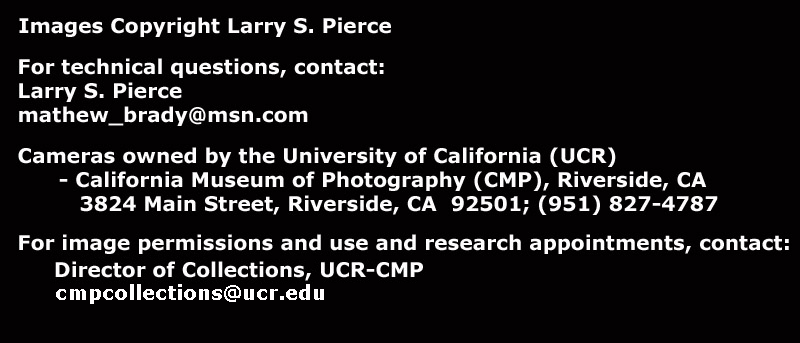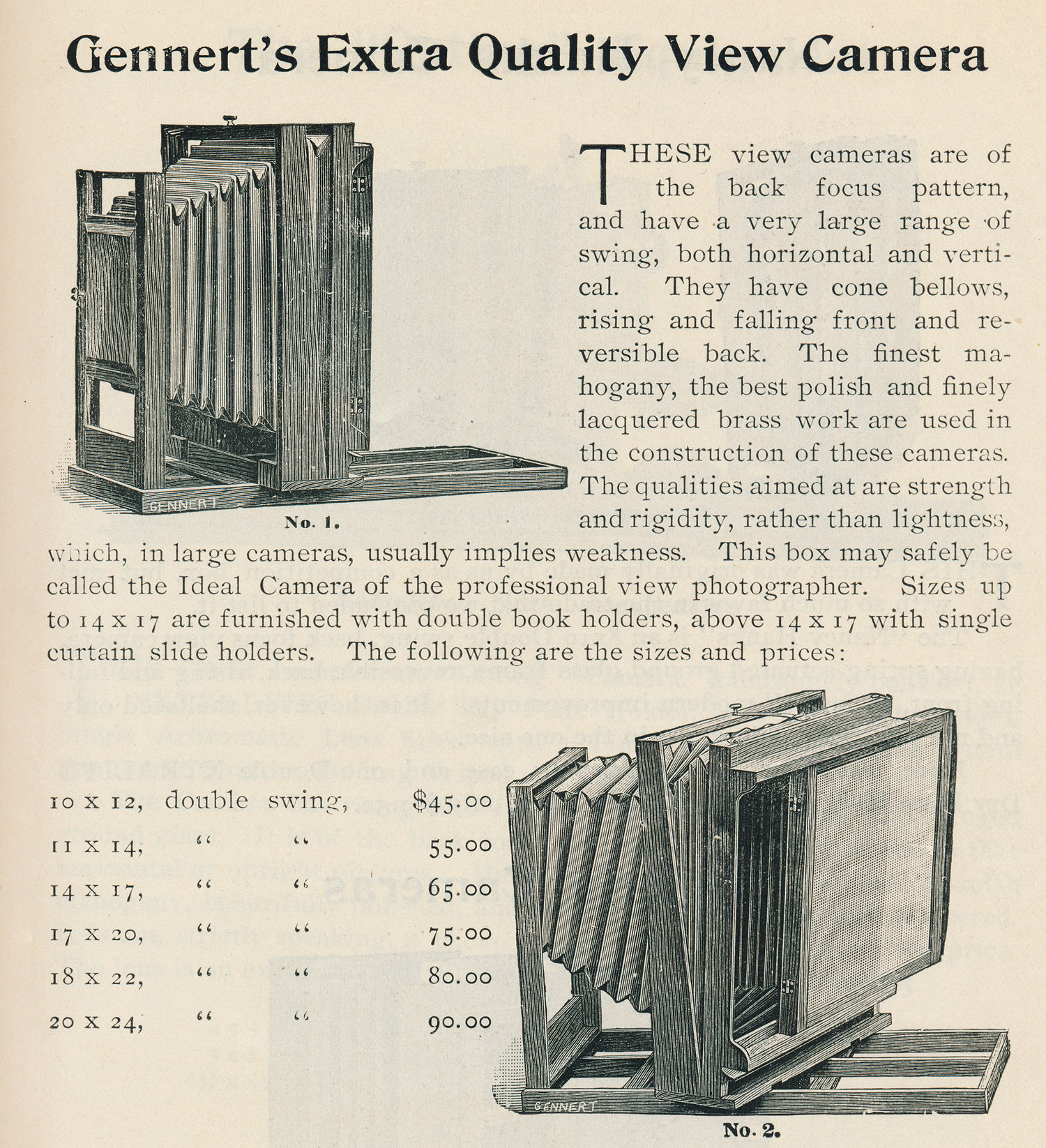G. Gennert, Rochester, New York, NY
Gennert's Extra Quality View Camera
Date Introduced: - ;
Years Manufactured: c.1895
- c.1895
Construction: rear focus
via push-pull, double swing, reversible by removable back,
Materials: mahogany body, cherry
base, brass hardware, black fabric bellows, French polish wood finish
Sizes Offered: 5x7, 5x8, 6 ½x8 ½,
8x10, 14x17
Notes: The
Extra
Quality View Camera is a model very similar to the
Burlington
and Nancy
Hanks.
Gennert Back Focus View Cameras
It has not been easy sorting out the rear focus view cameras of the G. Gennert Co., despite the fact that these rear focus cameras are the most commonly encountered of Gennert cameras. Gennert ran a distant third place to the two largest suppliers of photographic equipment: American Optical Co./Scovill Mfg. Co. and E. & H.T. Anthony & Co. Gennert catalogs, the best source of information on which designs or models of view cameras were produced and when, are woefully rare. The result of such rarity may be illustrated by the story of the Burlington, Nancy Hanks, and Extra Quality View models, narrated below.
First information:
The 1893 Gennert catalog (Descriptive Catalogue of Photographic Apparatus
and Supplies, G. Gennert
(New York, NY), c. 1893, p. 26) shows a rear focus model is called
The
Burlington Camera; its engraving is shown above.
Second information:
In a 1896 advertising page (Photo Beacon Vol. VIII No. 7, The Beacon
Publishing Co. (Chicago, IL) July 1896, glued in G. Gennert page No. 3),
The Burlington View Camera
was not mentioned, but there was a camera termed
The Nancy
Hanks View Camera, which used the identical engraving that had
previously been used for The Burlington.
The most reasonable conclusion is that
The Nancy Hanks was identical to
The Burlington Camera and is
merely a new name, a name that commemorates the mother of Abraham
Lincoln, Nancy Hanks Lincoln.
Third information:
The
1901 catalog states that The Nancy Hanks
Camera has a
shellac finish, not polished,
yet the observed example cameras of this design are French polished, as
are most of Gennert's view cameras of this era. This is a hint
that there might be a flaw in assuming that
The Nancy Hanks Camera is another
name for The Burlington Camera,
but what? Since they share the engravings, they are clearly
closely related.
Fourth information:
A catalog dated Jan. 1, 1895 finally lays it out,
having in the same catalog both The Nancy
Hanks Camera (page
40) and The Burlington Camera
(page 45).
As with the catalogs in which the models only appear one at a time, the
two cameras in the same catalog are illustrated using the same
engravings. In the written descriptions, we discover that they do,
indeed, have the same design and construction, even having the same
patented spring back, and use the same type of holders, the
Extralite. We also discover
that The Nancy Hanks Camera
is only made in 8x10" size, whereas The
Burlington Camera is made in 5x7, 5x8, 6½x8½",
8x10, 11x14, and 14x17" sizes. And, as previously noted in the
third information, the wood on The Nancy
Hanks Camera is finished with one layer of shellac, whereas
The Burlington Camera is
French polished (still using shellac, but with much more labor; see
description of wood finishes
on this web site for a description of the French polish technique).
As a consequence of the difference in labor,
The Nancy Hanks Camera, in its
only size: 8x10", had a price of $17.50, whereas
The Burlington Camera 8x10" size
had a price of $25.00 (both models sold without lenses).
Some more information from the 1895
catalog:
Usually, camera catalogs are organized to show all the
studio cameras consecutively, then show all the view cameras. What
was meant by a view camera in the day is one intended to be
taken into the field, usually lighter than a studio camera and having a
platform or bed that folds or dismantles to make it small.
Contrary to the general rule, The Nancy
Hanks View Camera is found in the Jan. 1, 1895 catalog to be
listed between two studio cameras, and the other view cameras are mixed
with folding leather-covered and box cameras. This mixing matters
because there is another camera amongst the studio cameras that appears
to be another model identical to The
Nancy Hanks and The
Burlington, except that its back is different - an older
style that is less handy than the patented spring back. This
camera is called Gennert's Extra Quality
View Camera. It is offered in sizes 10x12, 11x14,
14x17, 17x20, 18x22, and 20x24, thus ranging larger than
The Burlington Camera.
While the description does not mention that it has a folding bed, and
its engravings are from viewpoints that preclude seeing any indication
of a break in the bed, it is, after all, called a view camera,
which means it probably had one. Therefore, this is yet another
member in the Nancy Hanks/Burlington
group of similar view cameras, which now contains three models,
described as follows.
Similar Models of large rear-focus G. Gennert view cameras:
All three variations are rear focus, double swing, front rise, push-pull focus, mahogany and cherry, brass hardware view cameras. The vertical swing hinges from the bottom, and locks with a clip on the top. The descriptions below indicate how they differ from one another in finish and back/plate holder.
The Burlington
Camera:
Finish: French polish
Back: patent spring back and Extralite holder
The Nancy Hanks
View Camera:
Finish: Shellac, no polish
Back: patent spring back and Extralite holder
8x10 only
Gennert's
Extra Quality View Camera:
Finish: French polish
Back: slide-in book-type plate holder
Gennert Canvas Case Construction
Three Gennert cameras: the
Oxford Camera LP416, the
Brighton Camera
LP524, and two Burlington
Cameras on this page: the
Burlington Camera LP788 (6½x8½
above) and
Burlington Camera LP681 (8x10 below) were purchased with canvas
cases. All of said cases have a similar style, in that the top is hinged
on one side, then has a small overhanging flap on two sides, and a large
flap on the front. Since they were obtained from different sources, we
can safely assume that these are the original cases that were provided
by Gennert along with the cameras.
References:
Descriptive Catalogue of Photographic Apparatus
and Supplies, G. Gennert
(New York, NY), c. 1893, p. 26 (As The
Burlington Camera)
Descriptive Catalogue of Photographic Apparatus and Supplies, G.
Gennert (New York, NY), dated Jan. 1, 1895, p.39
Photo Beacon Vol. VIII No. 7, The Beacon
Publishing Co. (Chicago, IL) July 1896, glued
in G. Gennert page No. 3 (As The Nancy Hanks)
Catalogue of Photographic Apparatus and Supplies,
G. Gennert (New
York, NY), 1901, p. 60 (As The Nancy Hanks)
Catalogue of Photographic Apparatus and Supplies,
G. Gennert (New
York, NY), 1903 (As The Nancy Hanks)

